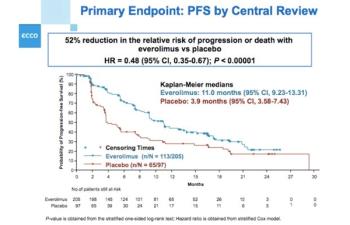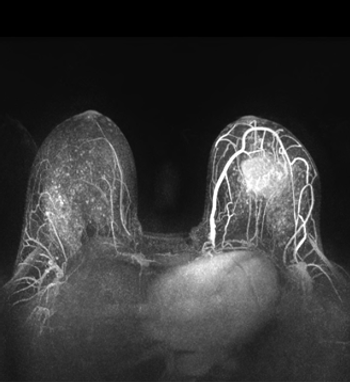
In Hodgkin lymphoma survivors, both mean heart radiation dose and cumulative dose of anthracyclines significantly predicted cardiovascular disease.

Your AI-Trained Oncology Knowledge Connection!


In Hodgkin lymphoma survivors, both mean heart radiation dose and cumulative dose of anthracyclines significantly predicted cardiovascular disease.

The FDA announced the approval of trabectedin (Yondelis) for the treatment of liposarcoma and leiomyosarcoma that is either unresectable or has metastasized.

Hypofractionated radiation therapy appears to lead to similar efficacy and safety as a standard radiation therapy regimen for men with low-risk prostate cancer.

Melanoma has historically been considered a radioresistant tumor. Emerging data have challenged this viewpoint. The potential roles of radiation therapy in the treatment of patients with melanoma will be reviewed here.

One of the more difficult topics to discuss concerning the ethics of healthcare is distributive justice-the fair distribution of benefits, risks, and costs.

Small intestinal “carcinoid” or well-differentiated grade 1 neuroendocrine tumors can have an insidious onset or be diagnosed serendipitously at the time of surgery, during the workup for another disorder, or during a screening test.

It is incumbent on melanoma and radiation oncology researchers alike to further our understanding of when and how RT can help patients.

A new study at a single center in Japan found no significant differences in the rate of BRCA mutations between ovarian cancer patients with or without family histories of the mutations and recommends that BRCA1/2 testing be required for all ovarian cancer patients

Palliative care should be provided with cancer care early in the course of illness for all patients with advanced disease, according to a new guidance statement from ASCO and the American Academy of Hospice and Palliative Medicine.

This slide show features some of the top highlights on neuroendocrine tumors, breast cancer, and renal cell carcinoma to come out of the 2015 European Cancer Congress in Vienna.

A simple one-question tool may help oncologists more accurately predict cancer patients’ prognoses and know when to initiate end-of-life discussions.

A novel program combining radiation oncology with palliative care in patients with painful bone metastases increased the use of proven treatments while maintaining pain management, decreased palliative radiation use, and decreased hospital length of stay.

The use of bone-seeking radionuclides effectively controlled bone pain in men with prostate cancer metastatic to the bone, according to the results of a systematic review.

Almost 40% of patients undergoing palliative radiotherapy to treat symptomatic bone metastases experienced pain flare, according to an observational study.

A new genetic analysis found five new genetic variants that raise the risk for gliomas. One of the five was associated with a sharply increased risk for glioblastoma.

Significantly more women are now aware of reconstructive surgery options after mastectomies for breast cancer, following coverage of Angelina Jolie’s mastectomies in 2013.

A phase III study showed that APF530 could improve control of emesis in cancer patients receiving highly emetogenic chemotherapy.

A new study found that magnetic resonance imaging (MRI) screening improved the detection of small, high-grade breast cancers in women with average risk.

Rural cancer patients often face substantial barriers to receiving optimal treatment, including availability of cancer care providers, distance to services, lack of public transportation, financial barriers, and limited access to clinical trials. However, a number of promising approaches may address some of these challenges.

Current data challenge the statement that recommendations for postmastectomy radiotherapy should be based on the highest clinical or pathologic stage. Instead, data suggest that in a majority of patients, the pathologic stage after neoadjuvant chemotherapy carries more prognostic value.

As technology has affected every segment of society, we in the oncology community have a responsibility to make every effort to utilize these advances to enable the broadest possible outreach to our patient population in a continual process of quality improvement.

A high number of patient life-years are lost to regulatory delays for drug approvals, according to an analysis presented at the 2015 World Conference on Lung Cancer.

According to a recent study, treatments aimed at preventing skeletal-related events in patients with advanced cancer and bone metastases could reduce pain and the need for opioids.

A payment system for colonoscopies offering full insurance coverage at low-priced facilities and cost sharing at high-priced alternatives reduced spending with no increase in complications.

Adding pertuzumab to first-line therapy for HER2-positive breast cancer has been shown to yield a survival benefit, but a new analysis says adding the drug is not cost effective.

The US Food and Drug Administration has approved rolapitant for the prevention of delayed phase nausea and vomiting associated with chemotherapy.

Perineural invasion was a significant predictor of increased risk for bone metastases in men with prostate cancer who had suspicion for bone metastases after a whole-body bone scan.

No matter how much education my staff and I participate in, we will never cover every single possible adverse event that an individual may experience. And in some cases, when a patient can't explain their symptoms, we can be at a loss as to how to help them.


Warfarin and a low molecular-weight heparin produced similar results in reducing major blood clots in cancer patients treated for acute venous thromboembolism.